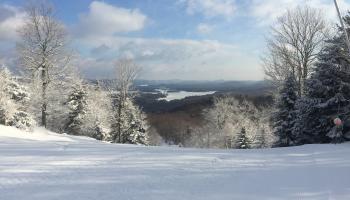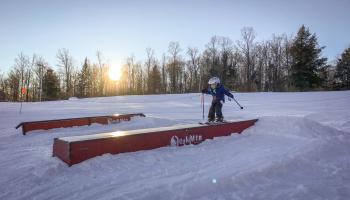On the ski reports from I SKI NY, we use two-letter surface condition codes to signify what the conditions are like on the snow. These are Article 18-approved, the New York Safety in Skiing law. Ski areas endeavor to inspect trails and report conditions consistent with terminology descriptive of surface condition(s) developed by the New York Ski Industry Association, Ski Areas of New York, Inc. as follows:
BS= BARE SPOTS - Areas of exposed underlying trail surface, NOT covered with sufficient amounts of any form of snow, ice, or other skiable material. No skier should attempt to ski over or through any bare spot or spots.
CL= CLOSED
CO= CORN SNOW - Large ice-like granules, which are loose during above-freezing temperatures and which freeze together during below-freezing temperatures. Corn snow is usually a product of the above/below freezing cycle of temperatures typical of spring days. Large ice-like granules which remain frozen together in extended cold periods or chunks of ice created by incomplete grooming or icy surfaces are not characteristic of corn snow.
FG= FROZEN GRANULAR - Granular snow which was once wet and which has frozen together forming a rather solid or crusty-textured surface. It can return to loose granular after thawing or being worked by a grooming machine, or from the effects of skier traffic breaking up the crust. Frozen granular snow will support a ski pole stuck into it. However, if the pole makes ice chips and the surface will not support the pole, the surface is ICY.
HP= HARD PACK - Hard pack snow is a dense, compressed snow condition harder than packed powder and softer than ice.
IP, IS= ICE PATCHES, ICY SURFACE - Ice represents a hard, glazed surface usually created by freezing rain, or old surface snow melting and quickly refreezing again, or by groundwater seeping up into the snow and freezing. Also may describe a very wet surface that has been skied into a smooth surface while above-freezing temperatures are existent and then rapidly dropping temperatures occur. When broken, ice breaks into chunks rather than granules. Patches describe localized occurrences of ice; surface describes a more prevailing icy condition on the slope.
LG= LOOSE GRANULAR - Loose granules similar to rock salt, usually formed after powder snow thaws, refreezes and crystallizes; or an accumulation of sleet. Loose granular also may characterize surface conditions produced by machine conditioning of frozen granular or icy surfaces.
O= OPEN
P= POWDER - New snow generally of dry and fluffy consistency. Will not make a snowball easily.
PP= PACKED POWDER - Loose powder snow compacted by rollers, drags, or other mechanical apparatus or by skier traffic to a state which leaves little air space between particles. It is no longer fluffy, but it is not so extremely compacted that it is hard and icy.
SC= SPRING CONDITIONS - This term is used to characterize the wide variety of surface conditions that result from the alternate freezing and thawing of snow cover in spring weather. This term is used in place of other terms when the usual surface descriptions cannot accurately or completely describe the situation, that is, when no single surface type covers at least 50% of the skiable surface of a trail.
TC= THIN COVER - Indicates that the cover that currently exists will decline in quality due to skier traffic an may break through to the underlying trail surface. Thin Cover indicates that Bare Spots are anticipated to develop in the area during the day.
V= VARIABLE - A wide variety of conditions that cannot accurately or completely be described using usual terminology, such as when no single surface type predominates.
WG= WET GRANULAR - Loose or frozen granular snow which has become wet and soft after a thaw or from a rainfall.
WP= WET POWDER - Powder snow that is wet when it falls (you can easily make a snowball), or dry powder that becomes wet as the temperature rises above freezing or is dampened by rain.
Alphabetical Legend of Codes Used
BS=Bare Spots; CL=Closed; CO=Corn; FG=Frozen Granular; HP=Hard Pack; IP=Ice Patches; IS=Icy Surface; LG=Loose Granular; O=Open; P=Powder; PP=Packed Powder; SC=Spring Conditions; SM=Snowmaking in progress; TC=Thin Cover; V=Variable; WG=Wet Granular; WP=Wet Powder





